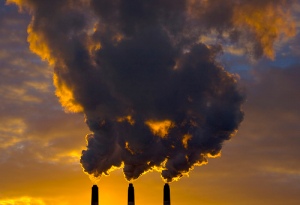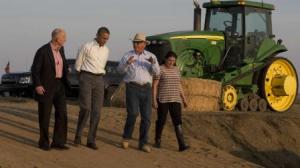Joe Del Bosque’s workers are tending irrigation lines and priming pumps for the cantaloupe season on 1,000 acres north of Mendota, California, an area bigger than Central Park. The drought gripping the most productive U.S. agricultural region may claim more than half that land.
Mendota, in Fresno County near the middle of the state, calls itself the Cantaloupe Center of the World. In the last big drought five years ago, unemployment in the town soared to almost 50 percent and the line of farm workers at the local food bank stretched for blocks. Del Bosque had to cut his payroll 30 percent, and it will probably be worse this year, he said.
“Those are wages lost,” said the 64-year-old farmer. “It’s wages lost to real people. It’s a loss of revenue into the community. That money supports families, it supports businesses. It’s a terrible effect. And I’m just one farmer, a medium-sized farmer. So if all farmers suffer the same thing, you can imagine the ripple effect throughout the community.” 
Governor Jerry Brown declared a state of emergency for the world’s 10th largest economy after 2013 turned into the driest year on record. President Barack Obama will visit the county today as more farmers prepare to idle thousands of acres, boosting food prices across the U.S. and leaving thousands of farm workers jobless.
Mendota is in a 200-mile zone on the west side of the San Joaquin Valley that grows about 70 percent of California’s cantaloupes. The state provides three-quarters of the cantaloupes sold in the U.S. Planting begins as early as April, with the harvest between June and October, according to the California Cantaloupe Advisory Board.
Poor, Hispanic
The city of 11,000 rises from a flat state highway that pierces farmland 230 miles north of Los Angeles. The community depends mostly on agriculture and is 97 percent Hispanic. Just one in three people graduated from high school and per-person income is about $9,000 a year, according to U.S. Census data.
Mendota already suffers from 34 percent unemployment, five times the national rate. The numbers vary seasonally, with farm workers migrating to Mendota every year from as far away as El Salvador and Oaxaca, Mexico.
“These people live week to week and if their paycheck is short by $5, they go hungry,” said Chuck Herrin who runs an employment agency that provides contract laborers to local farms. “A lot of these people, frankly, they don’t have legal status so they can’t go on unemployment.”
$122,000 Houses
A federal medium-security prison on the southwest edge of town provides some jobs outside of farming. There’s a new subdivision of modest one-story houses and apartments on the north side, and a rundown mobile home park on the west. In 2012, the median home value was $122,000, one-third of the average price in California, according to Census data. Many buildings in the seven-block downtown are older, showing their wear in broken shutters and weathered paint.
In 2009, farmers in the area got 10 percent of the federally-controlled water they requested during a milder drought. At the time, unemployment soared to almost 50 percent.
This year, no one expects any federal water.
“Without water we can’t produce,” said Bill Diedrich, a fourth-generation California farmer who grows almonds along the west side of Firebaugh, eight miles up the road from Mendota. “Without water, we don’t have jobs for folks. It’s going to be devastating.”
Small-Town Life
Sam Rubio, a 30-year-old former science teacher, is the president of the local chamber of commerce and owns a small coffee shop anchoring a one-story downtown commercial building. He sells some pastries and a place to plug in laptop computers. He offers chess boards for kids and a room where local non-profit groups can meet.
People live in the area because they are dedicated to farming and enjoy the quiet, small-town life, Rubio said. Yet more and more of them are talking about moving, he said, in search of a place where the crops are more certain.
“My worst fear is that we would have to close up shop,” Rubio said. “We’re a luxury. That’s just the truth. We are the last thing that parents are thinking about when they are thinking of providing for their children. They think the grocery store first, then gas and clothing and shoes.”
Top Producer
Fresno County supplied $6.6 billion of agricultural products in 2012, the top-producing county in the U.S. by gross value. With the drought, its farmers and ranchers are expected to fallow 250,000 acres this year, a quarter of its irrigated land and an area bigger than Manhattan, according to Ryan Jacobsen, chief executive of the Fresno County Farm Bureau. 
It’s not only the lack of rain that’s crippling farms. For years, the federal government and the state have reduced water allocation to a fraction of what is needed because of environmental laws protecting endangered fish and wildlife. As the state’s population grew to more than 38 million, few new dams and reservoirs were built to guard against dry years.
“Our farmers have been imaginative enough to maintain a good business until now,” said Steve Malanca, general manager of a John Deere (DE) farming equipment dealership in Firebaugh. “We’re going to be in some uncharted territory. With the zero allocation, I can tell you that my customers’ priority is not farm equipment. It’s water.
‘‘That translates into less sales, and not only farm equipment,” he said. “It’s farm fertilizer, farm seeds, it’s the local parts house in town, the local restaurants and the local barber. It affects us all.”
Price Spike
Ranchers and farmers who can buy water on the open market are paying as much as 10 times what it would cost in a typical wet year. Sheridan Nicholas, the water resources manager at the Wheeler Ridge-Maricopa Water Storage District near Bakersfield, bid on water that a neighboring district had put up for sale, only to find that local cattle ranchers were offering about 35 percent more, as much as $1,350 per acre-foot.
An acre-foot is the volume needed to cover an acre of land one foot deep with water and is used as a measure of large volume.
“If a state water contractor got 100 percent of their allocation, that water would typically go for about $100 an acre-foot,” Nicholas said. “It is so dry that there just isn’t enough water to buy, and that’s what made that water so valuable.”
The state saw relief last weekend as the most powerful storm to hit California in more than a year dropped several inches of rain in some spots and several feet of snow in the mountains. One reservoir rose as much as 15 feet in four days.
Northern California, where rainfall and snowmelt is collected and then fed down to cities and farms, has received just 8 inches of rain since July 1, according to the National Weather Service. That’s 14 inches below normal for Feb. 12, with more than half of the rainy season already over.
“I pray to God that we continue to get some rain,” said Mendota’s Mayor Pro Tem Joseph Amador, a retired detective who runs a local hotel. “There are some hard working people out here that want to work. They don’t need to be home stressing about what food is going to come to their table for their family tomorrow.”
Another great Green article from Green Halo
Track your recycling at www.greenhalosystems.com
Follow Green Halo on Twitter at http://twitter.com/greenhalousa
 According to the WHO, air pollution is responsible for one death in eight every year. Overall, 4.3 million deaths worldwide were linked in 2012 to indoor pollution primarily due to cooking with coal, dung, or wood stoves. Outdoor pollution from diesel engines and fires were linked to 3.7 million deaths. Many populations are exposed to poor air quality in both settings, causing a degree of overlap within the aggregate figure of seven million deaths. Further chronic health risks such as birth defects and impaired cognitive abilities in children add to the already sobering statistics.
According to the WHO, air pollution is responsible for one death in eight every year. Overall, 4.3 million deaths worldwide were linked in 2012 to indoor pollution primarily due to cooking with coal, dung, or wood stoves. Outdoor pollution from diesel engines and fires were linked to 3.7 million deaths. Many populations are exposed to poor air quality in both settings, causing a degree of overlap within the aggregate figure of seven million deaths. Further chronic health risks such as birth defects and impaired cognitive abilities in children add to the already sobering statistics.




